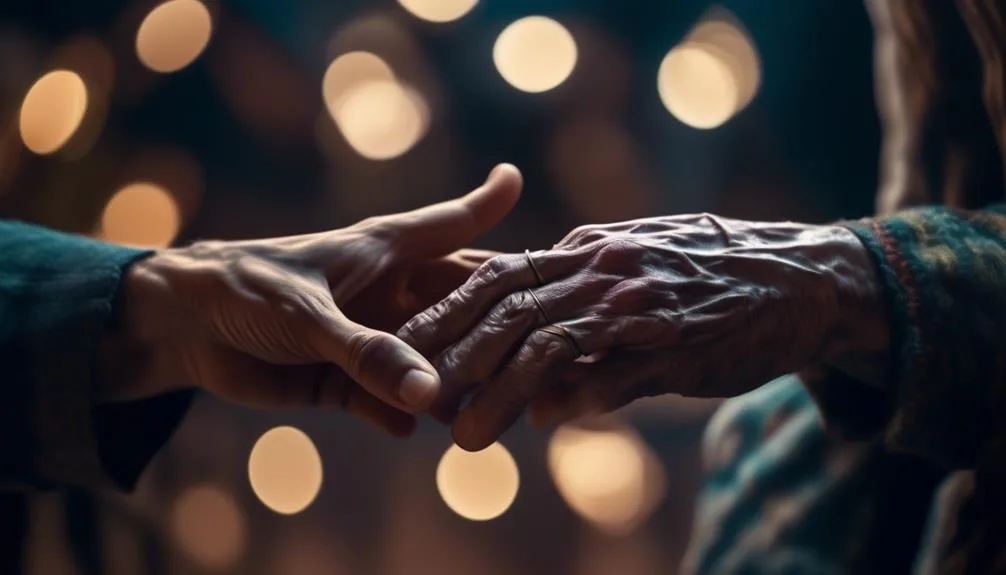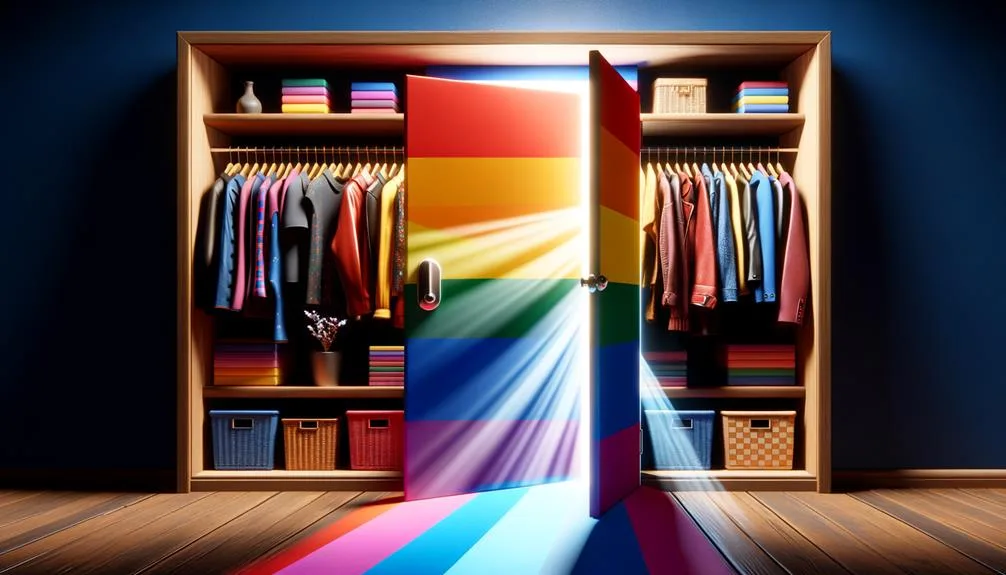In a world where society prides itself on being open-minded and accepting, one might assume that uncovering a man's bisexuality would be a straightforward task.
However, as the saying goes, looks can be deceiving. So, what are the secrets behind a man's bisexuality that often remain hidden beneath the surface?
This article aims to peel back the layers and explore the subtle cues and behaviors that may provide insight into a man's sexual orientation. From the nuances of flirting to the use of neutral pronouns, there are intriguing indicators that may shed light on a man's bisexuality.
But before we rush to conclusions, it is crucial to approach this topic with sensitivity and respect, for the goal is not to label or judge but to foster understanding and acceptance.
So, buckle up and prepare to uncover the secrets that lie within a man's bisexuality.
Key Takeaways
- Flirting and close relationships with other men, being overly chummy with attractive males, and spending excessive private time with a male best friend could potentially indicate a man's bisexuality.
- Intimacy issues, such as rating a 4 or 5 on the Kinsey Scale and engaging in intimate behavior with male friends, can be potential indicators of bisexuality when combined with other factors.
- High libido, hypersexuality, and openness to intimacy regardless of gender can also be signs of bisexuality, especially when observed in individuals falling in the middle of the Kinsey classification.
- Homophobic comments, secrecy, and the use of neutral pronouns in conversations about sexual past can suggest a man's bisexuality, although it is important to consider the context and other factors before jumping to conclusions.
Flirting and Close Relationships
In close relationships, observing a man's flirtatious behavior can provide potential insight into his bisexuality. Examples of such behavior include flirting with other men in front of their partner, being overly chummy with attractive males, or spending excessive private time with a male best friend. These behaviors can raise questions about a man's sexual orientation and should be approached with sensitivity and understanding. Exploring emotional connections and navigating boundaries are important aspects of any relationship. It is important to remember that individuals may have different ways of expressing their emotions and forming close friendships. While these behaviors alone may not definitively indicate bisexuality, they can be considered as part of a broader picture when exploring a man's sexuality. Open and honest communication is crucial in order to gain a deeper understanding of one's partner and to ensure a healthy and supportive relationship.
Intimacy Issues
Observing a man's flirtatious behavior and exploring emotional connections in close relationships can lead to potential insights into his bisexuality; another aspect to consider is the presence of intimacy issues.
Understanding intimacy is crucial in navigating relationships with bisexual individuals. Bisexuality acceptance involves acknowledging that intimacy issues may arise due to the unique experiences and challenges faced by individuals who are attracted to more than one gender. It's important to recognize that intimacy issues aren't exclusive to bisexuality, but can be present in any sexual orientation.
Libido and Sexual Orientation
The relationship between libido and sexual orientation is a complex and multifaceted topic that requires careful examination and consideration. Exploring sexual desire is crucial in understanding sexual fluidity.
Bisexual individuals have been found to have high libidos, suggesting a potential connection between sexual orientation and sexual drive. However, it's important to note that bisexuality and homosexuality don't necessarily lead to higher levels of promiscuity. Instead, individuals falling in the middle of the Kinsey classification, who are open to intimacy regardless of gender, may have a higher libido.
When assessing a man's sexual orientation, considering their libido as one of the indicators, in combination with other factors, can provide valuable insights. Understanding the complexities of libido and sexual orientation can contribute to a more comprehensive understanding of human sexuality.
Tactile Behavior

When considering a man's sexual orientation, a valuable aspect to examine is his tactile behavior, which can provide insights into his potential bisexuality. Tactile behavior refers to how a man interacts physically with others, particularly in terms of boundaries and appropriate physical touch.
It's important to understand the cultural context of tactile behavior, as different cultures have varying norms and expectations regarding physical touch. Observing whether a man is physically affectionate with other men, crosses the line in touching and roughhousing, or is more physically close to other men in public can indicate the possibility of bisexuality.
However, it's crucial to avoid making assumptions based solely on tactile behavior and to consider other factors in order to gain a more accurate understanding of a man's sexual orientation.
Homophobic Comments

Homophobic comments made by a man can potentially serve as an indicator of bisexuality when considering his sexual orientation. Exploring internalized homophobia and understanding the impact of societal taboos is crucial in this context.
Bisexual individuals often face discrimination and may hide their true preferences, leading to overcompensation through homophobic remarks. These remarks can manifest as overtly homophobic statements or actions.
It's important to note that making homophobic comments doesn't automatically mean someone is bisexual, as it could also be a result of ignorance or prejudice. However, when combined with other factors such as intimate behavior with male friends or intimacy issues, homophobic comments can provide insights into a man's bisexuality.
It's important to approach this topic with sensitivity, understanding, and open-mindedness.
Frequently Asked Questions
How Can One Differentiate Between Harmless Flirting and Flirting That May Indicate Bisexuality in a Man?
Differentiating between harmless flirting and potentially indicating bisexuality in a man can be challenging. It requires considering various factors, such as the intensity of the flirtation, the individual's behavior with different genders, and open communication about their sexual preferences.
What Are Some Other Factors, in Addition to a High Rating on the Kinsey Scale, That May Suggest Intimacy Issues and Potential Bisexuality in a Man?
Intimacy issues can suggest potential bisexuality in a man. Factors like a high rating on the Kinsey scale and a craving for emotional connection may also indicate these issues.
Are There Any Specific Behaviors or Actions That Can Help Identify a Man's Sexual Orientation Based on His Libido?
Identifying a man's sexual orientation based on his libido can be challenging. It is important to differentiate between harmless flirting and indicators of bisexuality. Other factors, such as behavior and self-identification, should also be considered.
How Can One Determine if a Man's Tactile Behavior With Other Men Is Within the Realm of Normalcy or if It May Signify Bisexuality?
Determining if a man's tactile behavior with other men is normal or indicative of bisexuality requires considering societal stigma and internalized homophobia. Creating a safe environment for self-discovery is crucial for unveiling his true sexuality.
Are There Any Other Indicators, Apart From Making Homophobic Comments, That May Suggest a Man Is Bisexual?
Indicators of bisexuality include exploring personal experiences, societal pressures, fluidity, and self-discovery. Communication about stereotypes and societal expectations can lead to acceptance. Understanding these indicators requires objective, evidence-based analysis.
Conclusion
In conclusion, while uncovering a man's bisexuality can be challenging, there are various indicators and behaviors that may suggest this sexual orientation.
From flirting with other men to the use of neutral pronouns, these subtle signs can help shed light on someone's true preferences.
However, it's crucial to approach these observations with caution and avoid jumping to conclusions.
By fostering understanding and creating a safe space, we can encourage individuals to express their true selves without judgment or prejudice.

